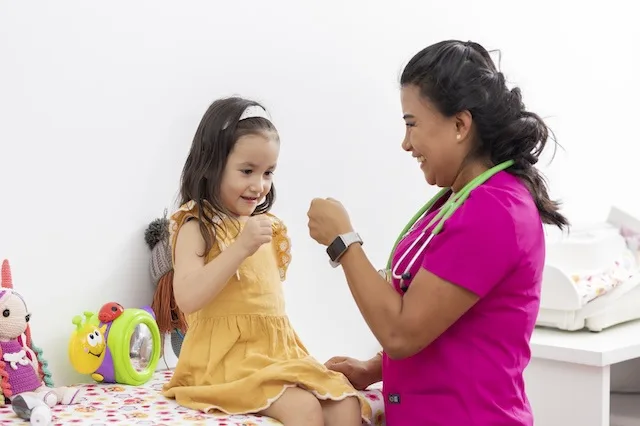Play and comfort techniques play a significant role in the healing and development of children in pediatric nursing settings.
This article explores what play and comfort techniques are, provides examples, and explains why they are essential for pediatric patients.
Understanding play and comfort techniques
Play techniques
Play is a vital part of a child’s development. It is through the process of play that children begin to learn about the world around them, develop social skills, and express their emotions. In a healthcare setting, play techniques involve using play as a therapeutic tool to help children cope with medical procedures, reduce anxiety, and support normal growth and development.
Pediatric nurses can employ these techniques to include activities like drawing, storytelling, role-playing, and the use of toys and games to create a sense of normalcy and control.
Comfort techniques
Comfort techniques are strategies used to alleviate pain, stress, and anxiety in pediatric patients. These techniques can range from physical interventions, like swaddling to psychological strategies, such as distraction, relaxation exercises, and the presence of a comforting object or person.
The goal of comfort techniques is to create a soothing environment that helps children feel safe and secure during medical care.
Examples of play techniques
Before pediatric nurses implement play and comfort techniques, assess the child’s developmental level, interests, and coping style to tailor play activities effectively. Integrate these strategies into the daily routine of pediatric care, ensuring it becomes a consistent part of the child’s hospital experience.
1. Medical play
- Role play: Allow children to use dolls or stuffed animals to simulate medical procedures. For example, a child might give a doll an injection or apply a bandage.
- Medical kits: Provide toy medical kits that include items like stethoscopes, thermometers, and syringes, helping children become familiar with medical equipment.
- Demonstration: Nurses can demonstrate procedures on a doll before performing them on the child, explaining each step to demystify the process.
2. Therapeutic play
- Art therapy: Encourage children to draw, paint, or engage in other creative activities. Art can be a medium for expressing feelings and processing experiences.
- Music therapy: Use music to soothe and distract children. Singing, playing instruments, or listening to favorite songs can reduce stress.
- Storytelling: Reading books or telling stories that address medical themes or hospital experiences can help children understand their situations and feel less alone.
3. Diversionary play
- Toys and games: Provide age-appropriate toys and games to distract children during procedures or while waiting. This can include board games, puzzles, or electronic games.
- Video games and tablets: Interactive technology can be particularly engaging and provide significant distraction during stressful times.
- Bubbles and lighted wands: Simple items like bubbles or lighted wands can quickly capture a child’s attention and divert their focus from medical procedures.
Examples of comfort techniques
1. Physical comfort techniques
- Swaddling: Wrapping infants snugly in a blanket can provide a sense of security and calm.
- Positioning: Using pillows, blankets, or specially designed supports to position the child comfortably during procedures or while resting.
- Skin to skin contact for infants: Skin to skin contact, also known as kangaroo care, is particularly effective for preemies and young infants
2. Emotional comfort techniques
- Parental presence: Allowing parents or caregivers to stay with the child during procedures and hospital stays provides immense emotional comfort.
- Comfort objects: Encouraging children to bring or keep a favorite blanket, stuffed animal, or toy can provide a sense of familiarity and security.
- Reassurance and communication: Using soothing words, explaining procedures in a child-friendly manner, and providing constant reassurance can alleviate fears.
- Imagery and guided relaxation: These techniques can be helpful when used with older children and teens. Guiding them to visualize a favorite place or engage in guided relaxation breathing exercises can reduce anxiety and promote calmness.
4. Environmental comfort techniques
- Child-friendly spaces: Creating a welcoming, child-friendly environment with bright colors, decorations, and play areas can make the hospital setting less intimidating.
- Quiet spaces: Providing access to quiet, low-stimulation areas where children can rest without the noise and bustle of the hospital.
- Personalization: Allowing children to personalize their space with drawings, posters, or items from home can make the environment feel more familiar and comfortable.
Importance of play and comfort techniques
Emotional well-being
Hospitalization and medical procedures can be frightening for children. Play and comfort techniques help to mitigate fear and anxiety, promoting emotional well-being.
Pain management
Effective pain management is crucial in pediatric care. Comfort techniques can help reduce the perception of pain and discomfort, making medical procedures more tolerable for young patients.
Enhanced cooperation
Children who are less anxious and more comfortable are more likely to cooperate with medical procedures. This cooperation can lead to more efficient and less stressful experiences for both the child and the healthcare team.
Developmental support
Play is essential for healthy development. Even in a hospital setting, children need opportunities to engage in play to continue their cognitive, emotional, and social development. Play techniques ensure that children's developmental needs are met, even when they are undergoing medical treatment.
Building trust
Establishing trust is fundamental in pediatric nursing. When nurses use play and comfort techniques, they build rapport and trust with their young patients. This trust is crucial for effective communication and care.
Family involvement
These techniques also support family-centered care. By involving parents and caregivers in the use of comfort strategies, nurses help families feel more empowered and involved in their child's care. This collaborative approach enhances the overall healthcare experience for both the child and their family.
In pediatric nursing, play and comfort techniques are integral to providing holistic and compassionate care to young patients.
By incorporating play and comfort techniques into their practice, pediatric nurses can help alleviate the fear and anxiety associated with medical procedures, support the developmental needs of children, and foster a positive healthcare experience.







